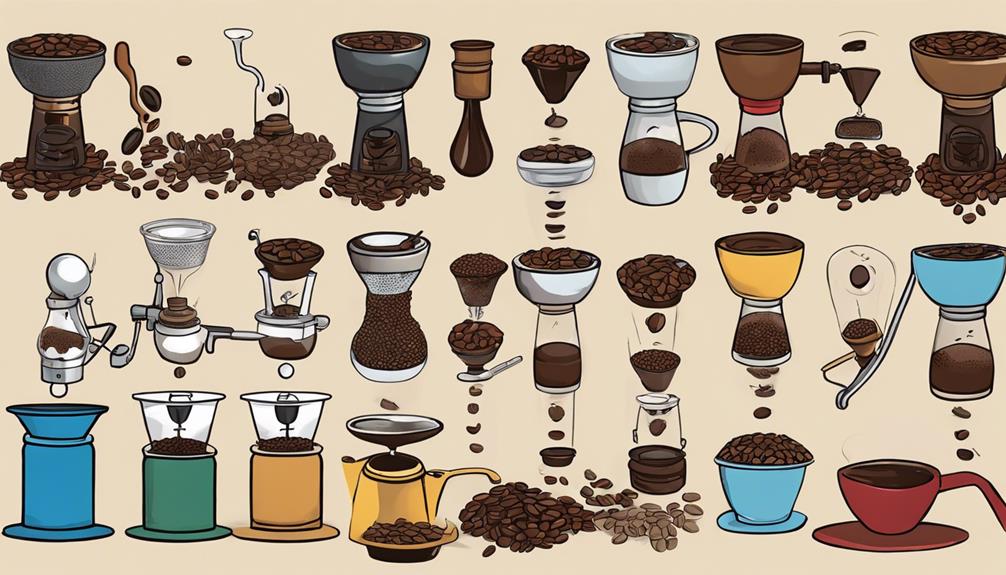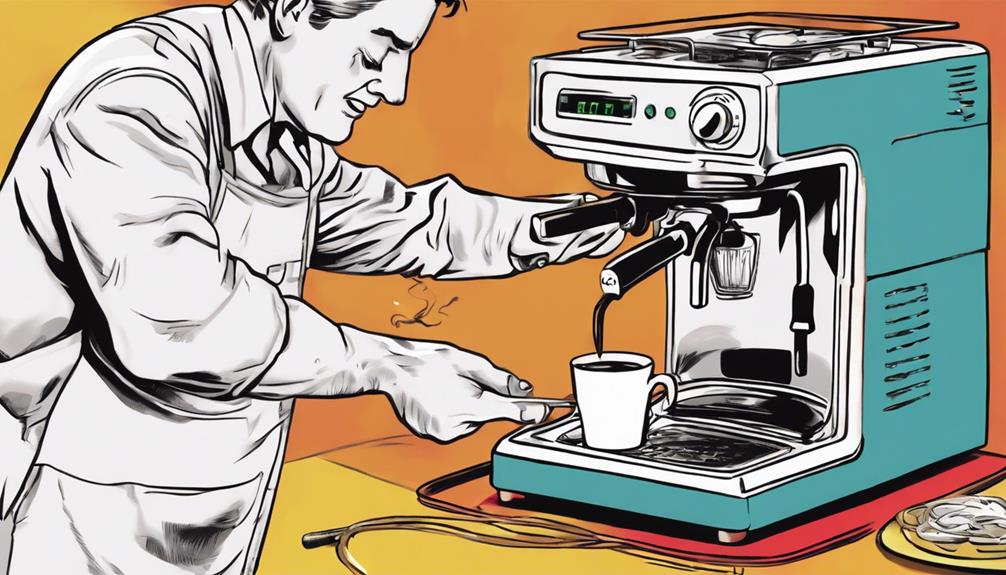Crafting distinctive coffee blends requires expertise in combining beans from multiple origins and roast levels to develop unique flavors. To start, explore various origins such as Africa, Latin America, and Asia. Experiment with blending different roast levels to add depth to your blends. Always begin with high-quality, freshly roasted beans. Understanding the proper blend ratios is crucial for achieving flavor balance. Roast each type of bean to perfection individually, then carefully blend them together. Fully engage your senses to perfect the art of coffee tasting. Prepare to enjoy the different textures and flavors of well-crafted blends, elevating your coffee experience to new levels!
Key Takeaways
- Experiment with diverse bean origins and roast levels.
- Blend carefully to highlight specific flavors.
- Combine beans from Africa, Latin America, and Asia.
- Explore blending various roast levels for depth.
- Aim for a harmonious flavor profile through precise ratios.
The Essence of Coffee Blending
To truly understand the art of coffee blending, one must grasp the essence of combining beans from diverse origins and roast levels. Coffee blending involves the intricate process of combining beans from different regions and roast levels to create unique flavor profiles.
By carefully selecting and blending beans, roasters can highlight a specific flavor or create a harmonious blend that offers a symphony of flavors in each cup.
Blending techniques play an essential role in crafting distinctive flavor profiles. Experimenting with beans from Africa, Latin America, and Asia can lead to unique tasting notes in blended coffee. Additionally, blending different roast levels adds depth and dimension to the final blend, ensuring a complex and well-rounded flavor profile.
Why Blend Coffee

Blending coffee enhances the complexity of flavor profiles by combining beans with distinct tasting notes from various origins. It ensures consistency in quality year-round, appealing to a wide range of palates.
By blending coffee, roasters can create cost-effective options by enhancing the flavors of more affordable beans with premium ones, offering a balanced cup without escalating costs. This practice allows for the creation of harmonious or complex blends to achieve specific flavor profiles by utilizing the individual characteristics of each bean. Different varietals, roast levels, and origins are mixed in coffee blending to create a symphony of flavors that cater to diverse preferences.
Whether you prefer a bold and rich cup or a light and fruity one, blending coffee allows for a tailored experience that meets a variety of tastes, making it a versatile and indispensable practice in the world of coffee crafting.
Getting Started With Coffee Blending
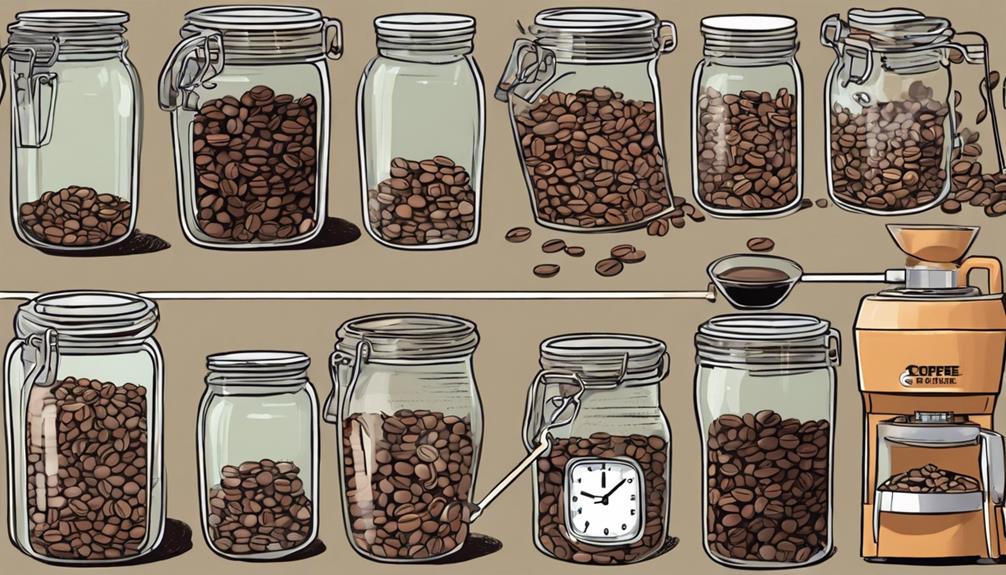
Consider beginning your coffee blending journey by exploring different bean origins, roast levels, and blending methods to craft unique and flavorful blends. When blending beans, it's essential to experiment with different bean origins such as those from Africa, Latin America, and Asia to uncover unique tasting notes. Additionally, blending various roast levels can add depth and complexity to your final blend. To guarantee a flavorful outcome, begin with high-quality beans that have been freshly roasted. By starting with these foundational elements, you set the stage for creating blends with diverse flavor profiles and characteristics.
| Blending Methods | Description |
|---|---|
| Classic Blend | Combines beans from different regions to create a balanced flavor profile. |
| Accent Blend | Incorporates a small percentage of a distinct bean to enhance specific tasting notes. |
| Layered Blend | Builds flavors by layering different beans with varying roast levels. |
| Single-Origin Blend | Showcases the unique characteristics of beans from a single region. |
Blending Ratios and Methods
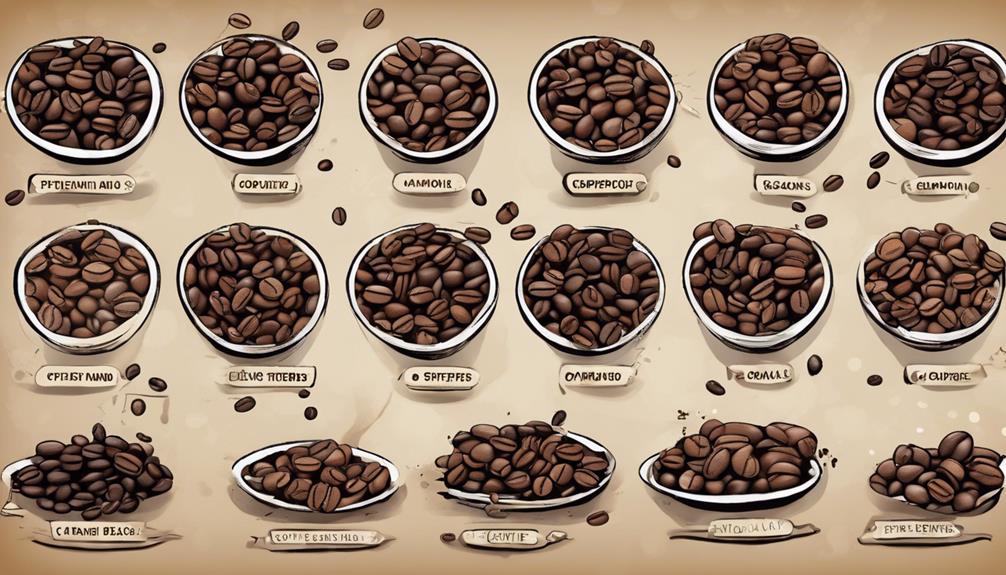
You're about to explore the essential aspects of blending ratios and methods in crafting unique coffee blends.
Understanding the significance of blend ratios and testing flavor balance will help you create harmonious and flavorful cups of coffee.
Get ready to experiment with different methods like classic, accent, layered, and single-origin blends to craft your perfect cup.
Blend Ratio Importance
Crafting unique coffee blends involves meticulously determining the blend ratio to achieve a harmonious flavor balance. The blend ratio, which defines the proportion of each coffee component in the final blend, is vital for creating a well-rounded flavor profile.
Experimenting with different blend ratios allows roasters to fine-tune the blend's taste, balancing sweet, mid-palate, and high notes to enhance complexity and taste experience. Consistent blend ratios are essential for ensuring uniformity in flavor across batches, maintaining quality and satisfying customers' expectations.
Precision in measuring and adjusting blend ratios is key to achieving a consistent and high-quality blend. By carefully adjusting blend ratios, roasters can create unique blends that stand out for their flavor balance and complexity. Remember, the blend ratio is the foundation of crafting exceptional coffee blends, requiring attention to detail and a commitment to achieving the perfect balance.
Testing Flavor Balance
To test the flavor balance of your coffee blends effectively, experiment with various blending ratios and methods to discover unique taste profiles. When aiming for a balanced blend, combine beans in equal proportions to achieve a harmonious flavor that complements each component. If you want to highlight specific flavor characteristics, consider using accent blends to enhance those notes. For a more intricate and complex flavor profile, try creating layered blends by incorporating beans roasted at different levels. Additionally, to showcase the distinct characteristics of specific regions, opt for single-origin blends that emphasize the terroir of the beans used.
| Blend Method | Description |
|---|---|
| Classic Blend | Combining beans in equal proportions for a balanced flavor profile. |
| Accent Blend | Highlighting specific flavor notes by enhancing certain characteristics. |
| Layered Blend | Building complexity with beans roasted at different levels for intricate flavors. |
| Single-Origin | Showcasing terroir and unique characteristics of specific regions through the blend. |
Blending and Roasting Process

When blending and roasting coffee, it's important to determine precise proportions for each component to achieve the desired flavor balance.
The first step is to roast each type of bean separately to their ideal roast levels using specific roasting techniques. This process ensures that each bean's unique flavors are brought out before blending.
After roasting, it's vital to allow the beans to cool and degas, which optimizes the development of flavors.
Once the roasted beans are ready, they're combined according to the specified proportions for the blend. This blending process is essential for creating a harmonious flavor profile.
Finally, the blended beans should rest for a period to allow the flavors to meld together seamlessly, resulting in a well-balanced cup of coffee.
The Art of Tasting
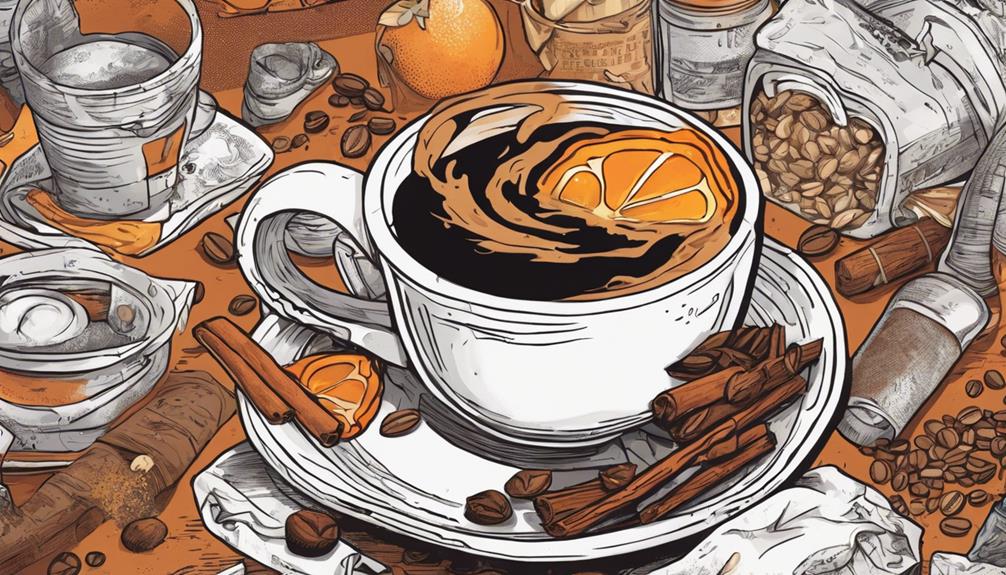
Engage your senses fully to master the art of tasting coffee blends accurately. When delving into the world of coffee tasting, remember to:
- Immerse yourself: Engage in tasting sessions with an open mind, ready to explore a myriad of flavors and aromas waiting to be discovered.
- Savor the moment: Take your time to appreciate the textures and nuances of different blends, allowing yourself to truly experience the richness each cup has to offer.
- Embrace the process: Use tasting sessions as a tool for evaluating and refining your blends, making thoughtful adjustments based on your impressions to create the perfect cup.
Frequently Asked Questions
How Do You Make Special Blend Coffee?
To make special blend coffee, you combine specific beans, roast levels, and varietals to craft a unique flavor profile. Experiment with ratios to highlight desired flavor notes, creating a distinct blend tailored to your preferences.
What Are Some of the Different Flavours You Can Get From Different Blends of Coffee?
You'll discover a symphony of flavors in coffee blends. From fruity and floral notes of African beans to the balanced sweetness of Latin American beans, each sip offers a unique experience. Experiment and savor!
How Do You Make a Custom Coffee Blend?
To make a custom coffee blend, start by selecting beans with complementary flavors. Experiment with different ratios, considering factors like origin and roast level. Blend beans separately, then mix for a harmonious profile. Taste test and adjust till perfect.
How Do They Make Different Blends of Coffee?
So, you want to know how they whip up those diverse coffee blends? Well, they mix beans from various spots, roast them just right, then blend them perfectly for that unique flavor punch.
Conclusion
Now that you've learned the basics of coffee blending, don't be afraid to experiment and get creative with your blends!
Remember, the key to crafting unique flavors lies in finding the perfect balance of different beans and roasts.
So go ahead, trust your taste buds and start blending your way to your own signature coffee blend.
Who knows, you might just discover the next big coffee trend!
